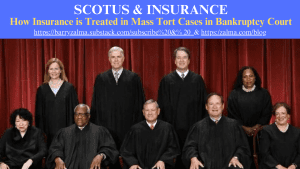SCOTUS & INSURANCE

Post 4825
See the full video at https://rumble.com/v54vxg9-scotus-and-insurance.html and at ttps://youtu.be/oHIClktLG-I
Between 1999 and 2019, approximately 247,000 people in the United States died from prescription-opioid overdoses. Respondent Purdue Pharma sits at the center of that crisis. Owned and controlled by the Sackler family, Purdue began marketing OxyContin, an opioid prescription pain reliever, in the mid-1990s. After Purdue earned billions of dollars in sales on the drug, in 2007 one of its affiliates pleaded guilty to a federal felony for misbranding OxyContin as a less-addictive, less-abusable alternative to other pain medications. Thousands of lawsuits followed. Purdue Pharma filed for bankruptcy and attempted to protect the Sackler family from individual tort actions.
Fearful that the litigation would eventually impact them directly, the Sacklers initiated a “milking program,” withdrawing from Purdue approximately $11 billion-roughly 75% of the firm’s total assets-over the next decade.
Those withdrawals left Purdue in a significantly weakened financial state. And in 2019, Purdue filed for Chapter 11 bankruptcy. During that process, the Sacklers proposed to return approximately $4.3 billion to Purdue’s bankruptcy estate. In exchange, the Sacklers sought a judicial order releasing the family from all opioid-related claims and enjoining victims from bringing such claims against them in the future. The bankruptcy court approved Purdue’s proposed reorganization plan, including its provisions concerning the Sackler discharge. But the district court vacated that decision, holding that nothing in the law authorizes bankruptcy courts to extinguish claims against third parties like the Sacklers, without the claimants’ consent. A divided panel of the Second Circuit reversed the district court and revived the bankruptcy court’s order approving a modified reorganization plan.
The Conclusion
In Harrington, United States Trustee, Region 2 v. Purdue Pharma L. P. et al., 603 U.S. __, No. 23-124, United States Supreme Court (June 27, 2024) the Supreme Court of the United States (SCOTUS) Justice Gorsuch writing for SCOTUS found that the bankruptcy code does not authorize a release and injunction that, as part of a plan of reorganization under Chapter 11, effectively seeks to discharge claims against the Sacklers, nondebtors, without the consent of affected claimants.
Insurance & Bankruptcy
The insurance assets-meaning assets to the limits of the debtor’s insurance coverage-are usually a key asset for the bankruptcy estate to compensate victims. But tort victims also use the tort of bad faith to allow them to “have direct action rights against the insurance carrier, even, in some cases, bypassing the debtor-insured.” That would obviously prevent the insurance money from being used as part of the bankruptcy estate.
To address those various collective-action problems, bankruptcy courts have long found non-debtor releases to be appropriate in certain complex bankruptcy cases, especially in mass-tort bankruptcies.
For example, after A. H. Robins declared bankruptcy in 1985 in the face of massive tort liability for injuries from its defective intrauterine device, the Dalkon Shield, nearly 200,000 victims filed proof of claims. A plan provision releasing the company’s directors and insurance company ensured that the estate would not be depleted through indemnity or contribution claims, or claims brought directly against the directors or insurer. Preventing the victims from engaging in “piecemeal litigation” against the non-debtor directors and insurance company was the only way to ensure “equality of treatment of similarly situated creditors.” Therefore, the Bankruptcy Court found (and the Fourth Circuit agreed) that the release was “necessary and essential” to the bankruptcy’s success. Ibid.; see 880 F.2d, at 701-702.
Protecting Mass Tort Victims from Eating Up all Insurance Proceeds
Without a coordinating mechanism, a victim’s (or group of victims’) recovery against one local entity could have eaten up all of the shared insurance assets, leaving all of the other victims with nothing.
Bankruptcy provided a forum to coordinate liability and insurance assets. A non-debtor release provision prevented victims from litigating outside of the bankruptcy plan’s procedures. And the provision therefore prevented one victim or group of victims from obtaining all of the insurance funds before other victims recovered.
Nothing in what SCOTUS wrote in the opinion should be construed to call into question consensual third-party releases offered in connection with a bankruptcy reorganization plan; those sorts of releases pose different questions and may rest on different legal grounds than the nonconsensual release at issue in this case.
Because this case involves only a stayed reorganization plan, SCOTUS did not address whether SCOTUS’ reading of the bankruptcy code would justify unwinding reorganization plans that have already become effective and been substantially consummated. By confining the opinion to the question presented, it held only that the bankruptcy code does not authorize a release and injunction that, as part of a plan of reorganization under Chapter 11, that effectively seeks to discharge claims against a nondebtor without the consent of affected claimants.
Because the Second Circuit held otherwise, its judgment is reversed and the case WAs remanded for further proceedings consistent with this opinion.
GORSUCH, J., delivered the opinion of the Court, in which THOMAS, ALITO, BARRETT, and JACKSON, JJ., joined. KAVANAUGH, J., filed a dissenting opinion, in which ROBERTS, C. J., and SOTOMAYOR and KAGAN, JJ., joined.
SCOTUS concluded that the Sackler family’s scheme to reduce the assets of Purdue Pharma to limit the exposure to their personal assets was improper. The scheme failed and the Purdue Pharma insurers and the Sackler family were not protected by the Bankruptcy proceeding since their liability and assets were different from the corporation that filed bankruptcy.

(c) 2024 Barry Zalma & ClaimSchool, Inc.
Please tell your friends and colleagues about this blog and the videos and let them subscribe to the blog and the videos.
Subscribe to my substack at https://barryzalma.substack.com/subscribe
Go to X @bzalma; Go to Newsbreak.com https://www.newsbreak.com/@c/1653419?s=01; Go to Barry Zalma videos at Rumble.com at https://rumble.com/c/c-262921; Go to Barry Zalma on YouTube- https://www.youtube.com/channel/UCysiZklEtxZsSF9DfC0Expg.
Go to the Insurance Claims Library – https://lnkd.in/gwEYk
Like this:
Loading…



